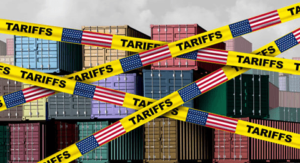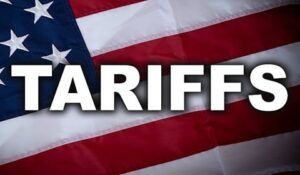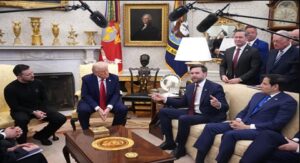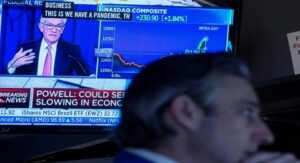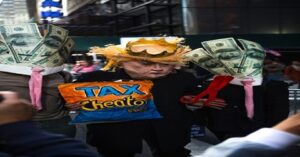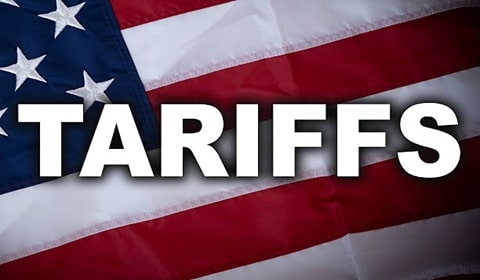
Trump's Tariff Chaos Threatens 80 Years of Economic Progress
Trump’s Tariff Chaos has thrown the global trade system into disarray, threatening decades of economic cooperation and progress. From the Silk Road to the WTO, trade has long united nations through shared prosperity and rules-based order. But Trump’s aggressive protectionism, erratic tariff policies, and disregard for international norms have undermined stability and trust.
As uncertainty grows, businesses hesitate, investment slows, and global growth stalls. The world stands at a critical crossroads—either capitulate to unilateral coercion or unite to defend open trade. A coordinated, principled response is urgently needed to preserve the foundations of global commerce before irreparable damage is done.
Trump’s Tariff Chaos:
For centuries, trade has shaped civilizations and global power structures. From the Silk Road to the modern WTO framework, international commerce has spurred growth, lifted millions out of poverty, and built interdependence among nations. But this progress now faces a serious threat. With the resurgence of U.S. protectionism under Donald Trump, the foundations of the rules-based global trade system are cracking.
Table of Contents
1. Trade’s Long Legacy
International trade has been a cornerstone of human development for thousands of years. Explorers like Marco Polo and empires like that of Alexander the Great expanded commerce and cultures alike. But for most of history, trade was shaped by military might and political dominance, not by mutual benefit. The emergence of thinkers like Adam Smith and David Ricardo revolutionized our understanding of trade.
Their economic theories debunked protectionism and showed that tariffs distort markets, raise prices, stifle innovation, and entrench monopolies. Over time, global economies increasingly embraced their ideas, giving rise to modern trade agreements based on predictability, reciprocity, and the rule of law—now under threat from Trump’s Tariff Chaos.
Read More: Will Trump’s Tariffs Accelerate America’s Economic Decline?
2. Post-War Reform
After World War II, a war-ravaged world needed a new economic order. Rather than exploiting its newfound dominance, the United States led the formation of a fairer, rules-based global trading system. The General Agreement on Tariffs and Trade (GATT) and later the World Trade Organization (WTO) institutionalized this vision.
Trump’s Tariff Chaos now threatens to undo this hard-won legacy, challenging the very principles that guided decades of cooperation. This shift marked a historic change. Instead of using power to control trade, nations pursued collective progress. Tariffs were lowered, multilateralism prevailed, and free trade was recognized as a driver of economic development. From the 1950s to the early 2000s, this system contributed to eight decades of economic growth and poverty reduction, even in once-protectionist developing countries.
3. Trump’s Reversal
The election of Donald Trump in 2016 marked a sharp reversal. In place of decades of bipartisan support for free trade, Trump launched an aggressive protectionist agenda. He initiated a trade war with China, imposed tariffs on U.S. allies, and undermined global trade norms.
In his second term, Trump has gone further still. A 10% baseline tariff now applies to all imports into the U.S., with the threat of escalation to higher levels. Chinese imports face tariffs as high as 145%, with China retaliating in kind. Trump’s Tariff Chaos has made American trade policy erratic and unpredictable, with tariffs being imposed, lifted, and reimposed within weeks. This chaos discourages investment and destabilizes the global economy.
Read More: Saudi Arabia’s Industrial Strategy: 7 Points Analysis
4. Power Over Principle
Trump’s administration claims its goal is to reduce trade deficits or force other countries to lower their tariffs. Yet the evidence contradicts these assertions. For example, the European Union offered to eliminate industrial tariffs entirely, but the U.S. rejected the offer. Singapore, which already imposes zero tariffs on U.S. goods and runs a trade deficit with the U.S., was still hit with a 10% import tax.
These actions reveal that Trump’s protectionism is less about fair trade and more about exercising dominance. Trump’s Tariff Chaos reflects a broader strategy of disruption that violates WTO rules and the principle of equal treatment among trading partners. This return to pre-WWII-style bilateral power dynamics undermines the rule of law in trade, eroding global trust and cooperation.
5. Cost of Uncertainty
One of the most damaging effects of the current U.S. trade policy is uncertainty. Trump’s Tariff Chaos has made it impossible for businesses to rely on stable rules or predictable tariffs when making long-term investment decisions. If this unpredictability continues, global economic growth could decline significantly.
The private sector thrives on clarity. Without it, supply chains are disrupted, capital is misallocated, and companies postpone or cancel expansion plans. The longer this environment persists, the more the world economy risks slipping into a period of stagnation and volatility. Protectionism may benefit a few domestic industries temporarily, but the overall cost to global growth is severe and mounting.
Read More: Is Trump’s Industrial Policy More Continuity Than Disruption?
6. A New Coalition
If the U.S. continues down this destructive path, other countries must act collectively. One promising idea is the formation of a new multilateral framework that upholds WTO principles while operating independently of the U.S.—a Minus US Trade Organization (MUTO). Trump’s Tariff Chaos has exposed the vulnerability of relying too heavily on a single power to uphold global trade norms.
Such a coalition would be grounded in mutual respect, rules-based dispute resolution, and zero tolerance for economic coercion. The U.S., while powerful, represents only about 9% of global exports and less than 5% of the world’s population. A unified alliance of other nations could diminish America’s leverage, shift the balance of power in trade talks, and serve as a counterweight to protectionism.
There is precedent for this. When Trump crippled the WTO’s appellate body by blocking judicial appointments, many countries voluntarily created alternative mechanisms to resolve trade disputes. This shows that international cooperation can prevail even without U.S. leadership.
7. Act Before It’s Late
Trade barriers tend to become entrenched once in place, as vested interests emerge to defend them. If the rest of the world waits too long to counter the Trump administration’s tactics, it may become impossible to restore the open global system that has underpinned prosperity since WWII. Trump’s Tariff Chaos has intensified this risk, creating a climate of uncertainty and encouraging protectionist impulses worldwide.
To avoid this fate, targeted countries must resist the urge to make unilateral concessions to the U.S. under its arbitrary 90-day negotiation threats. Instead, they should coordinate a firm, unified response. They must reaffirm their commitment to trade liberalization and fair practices, even if that means temporarily excluding the U.S. from the conversation.
Ultimately, the path forward requires global courage. The world must decide whether to tolerate the erratic whims of a single power or to build a more stable, inclusive trading system for the 21st century. If nations come together now, they can protect the legacy of open trade—and lay the foundation for renewed global growth.
Bottom Line
The story of global trade is not just about economics—it’s about values, cooperation, and shared prosperity. Today, that story is at a crossroads. Trump’s Tariff Chaos has amplified the return of protectionism, threatening decades of hard-won progress. But with collective action, a smarter and more stable global trading system can emerge—one that serves not just the powerful, but everyone. The world must not wait to act.

